ACURA CSX 2006 Service Repair Manual
Manufacturer: ACURA, Model Year: 2006, Model line: CSX, Model: ACURA CSX 2006Pages: 2893, PDF Size: 67.66 MB
Page 931 of 2893
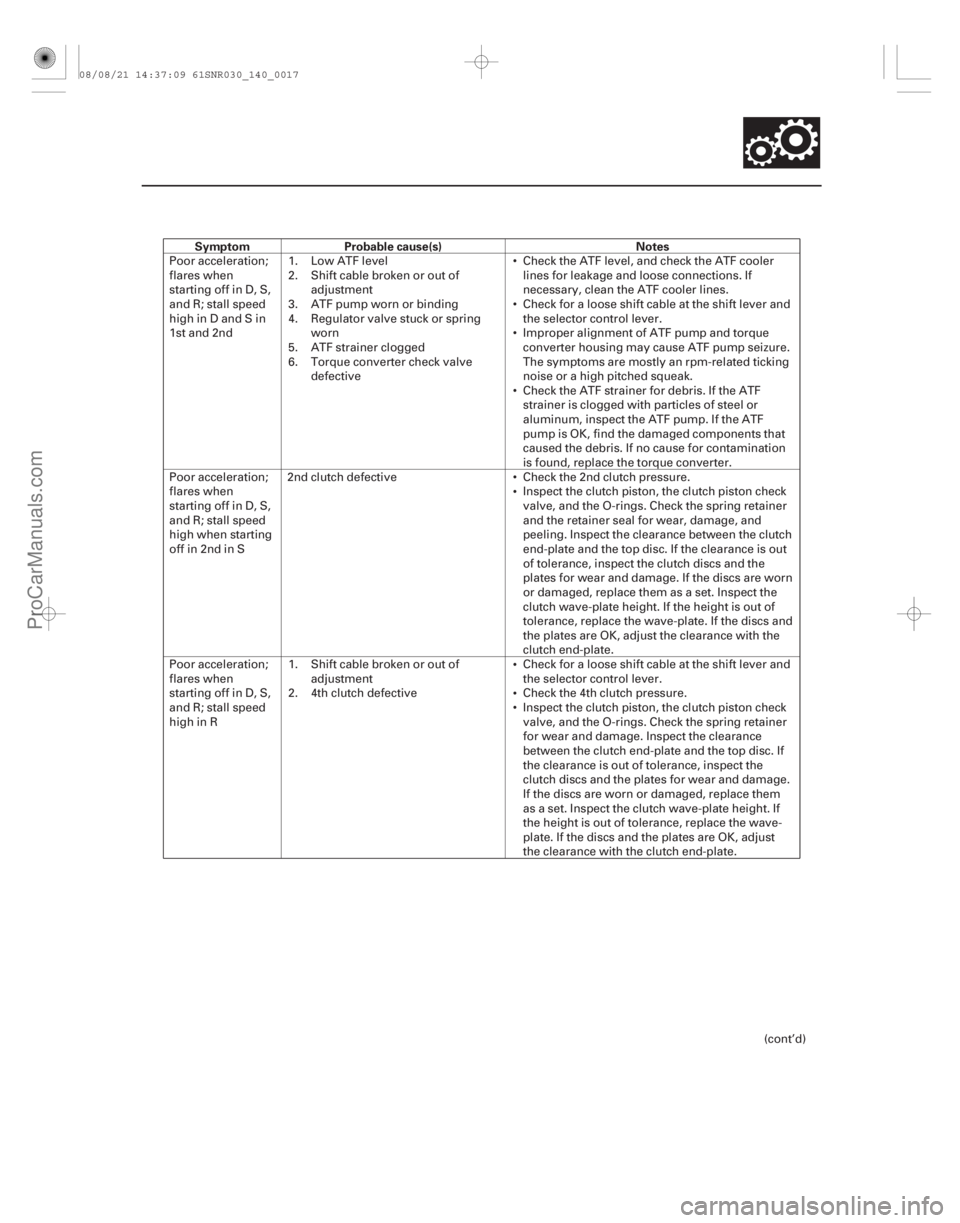
SymptomProbable cause(s) Notes
14-15
Poor acceleration;
flares when
starting off in D, S,
and R; stall speed
high in D and S in
1st and 2nd
1.
2.
3.
4.
5.
6.Low ATF level
Shift cable broken or out of
adjustment
ATF pump worn or binding
Regulator valve stuck or spring
worn
ATF strainer clogged
Torque converter check valve
defective Check the ATF level, and check the ATF cooler
lines for leakage and loose connections. If
necessary, clean the ATF cooler lines.
Check for a loose shift cable at the shift lever and
the selector control lever.
Improper alignment of ATF pump and torque
converter housing may cause ATF pump seizure.
The symptoms are mostly an rpm-related ticking
noise or a high pitched squeak.
Check the ATF strainer for debris. If the ATF
strainer is clogged with particles of steel or
aluminum, inspect the ATF pump. If the ATF
pump is OK, find the damaged components that
caused the debris. If no cause for contamination
is found, replace the torque converter.
Poor acceleration;
flares when
starting off in D, S,
and R; stall speed
high when starting
off in 2nd in S 2nd clutch defective Check the 2nd clutch pressure.
Inspect the clutch piston, the clutch piston check
valve, and the O-rings. Check the spring retainer
and the retainer seal for wear, damage, and
peeling. Inspect the clearance between the clutch
end-plate and the top disc. If the clearance is out
of tolerance, inspect the clutch discs and the
plates for wear and damage. If the discs are worn
or damaged, replace them as a set. Inspect the
clutch wave-plate height. If the height is out of
tolerance, replace the wave-plate. If the discs and
the plates are OK, adjust the clearance with the
clutch end-plate.
Poor acceleration;
flares when
starting off in D, S,
and R; stall speed
high in R 1.
2.
Shift cable broken or out of
adjustment
4th clutch defective Check for a loose shift cable at the shift lever and
the selector control lever.
Check the 4th clutch pressure.
Inspect the clutch piston, the clutch piston check
valve, and the O-rings. Check the spring retainer
for wear and damage. Inspect the clearance
between the clutch end-plate and the top disc. If
the clearance is out of tolerance, inspect the
clutch discs and the plates for wear and damage.
If the discs are worn or damaged, replace them
as a set. Inspect the clutch wave-plate height. If
the height is out of tolerance, replace the wave-
plate. If the discs and the plates are OK, adjust
the clearance with the clutch end-plate.
(cont’d)
08/08/21 14:37:09 61SNR030_140_0017
ProCarManuals.com
DYNOMITE -2009-
Page 932 of 2893
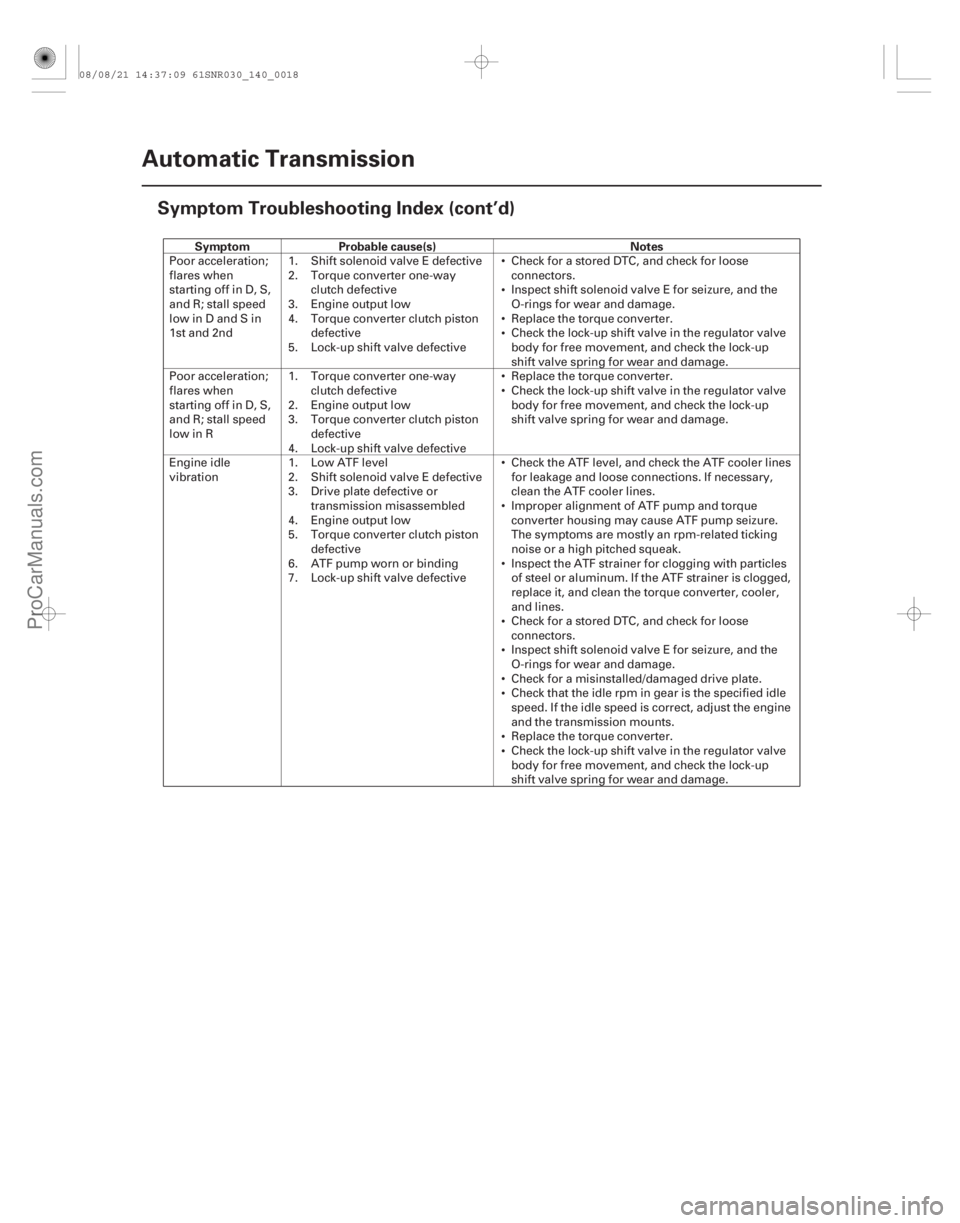
SymptomProbable cause(s) Notes
14-16Automatic Transmission
Symptom Troubleshooting Index (cont’d)
Poor acceleration;
flares when
starting off in D, S,
and R; stall speed
lowinDandSin
1st and 2nd
1.
2.
3.
4.
5.Shift solenoid valve E defective
Torque converter one-way
clutch defective
Engine output low
Torque converter clutch piston
defective
Lock-up shift valve defective Check for a stored DTC, and check for loose
connectors.
Inspect shift solenoid valve E for seizure, and the
O-rings for wear and damage.
Replace the torque converter.
Check the lock-up shift valve in the regulator valve
body for free movement, and check the lock-up
shift valve spring for wear and damage.
Poor acceleration;
flares when
starting off in D, S,
and R; stall speed
low in R 1.
2.
3.
4.Torque converter one-way
clutch defective
Engine output low
Torque converter clutch piston
defective
Lock-up shift valve defective Replace the torque converter.
Check the lock-up shift valve in the regulator valve
body for free movement, and check the lock-up
shift valve spring for wear and damage.
Engine idle
vibration 1.
2.
3.
4.
5.
6.
7.Low ATF level
Shift solenoid valve E defective
Drive plate defective or
transmission misassembled
Engine output low
Torque converter clutch piston
defective
ATF pump worn or binding
Lock-up shift valve defective Check the ATF level, and check the ATF cooler lines
for leakage and loose connections. If necessary,
clean the ATF cooler lines.
Improper alignment of ATF pump and torque
converter housing may cause ATF pump seizure.
The symptoms are mostly an rpm-related ticking
noise or a high pitched squeak.
Inspect the ATF strainer for clogging with particles
of steel or aluminum. If the ATF strainer is clogged,
replace it, and clean the torque converter, cooler,
and lines.
Check for a stored DTC, and check for loose
connectors.
Inspect shift solenoid valve E for seizure, and the
O-rings for wear and damage.
Check for a misinstalled/damaged drive plate.
Check that the idle rpm in gear is the specified idle
speed. If the idle speed is correct, adjust the engine
and the transmission mounts.
Replace the torque converter.
Check the lock-up shift valve in the regulator valve
body for free movement, and check the lock-up
shift valve spring for wear and damage.
08/08/21 14:37:09 61SNR030_140_0018
ProCarManuals.com
DYNOMITE -2009-
Page 933 of 2893
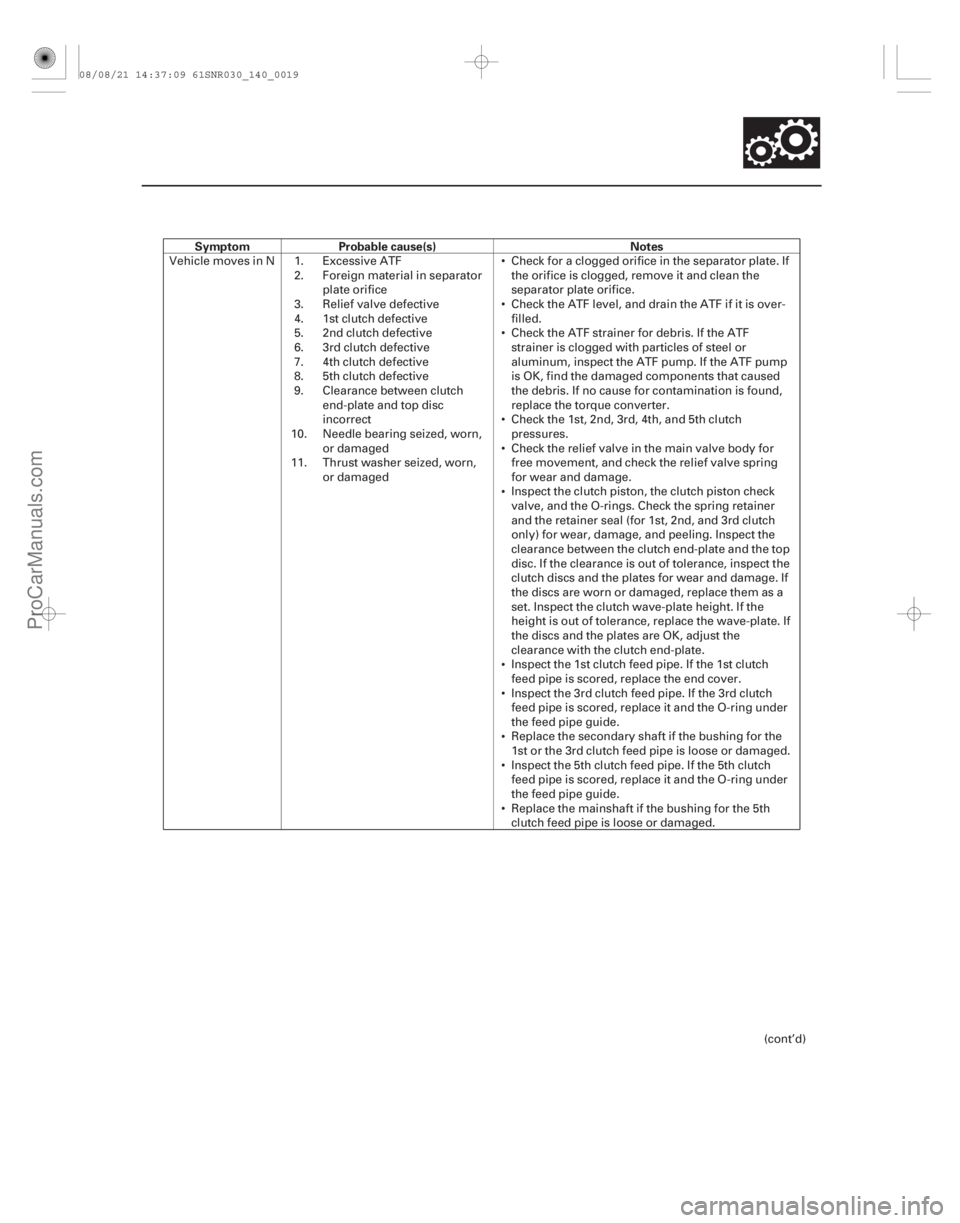
SymptomProbable cause(s) Notes
14-17
Vehicle moves in N 1.
2.
3.
4.
5.
6.
7.
8.
9.
10.
11. Excessive ATF
Foreign material in separator
plate orifice
Relief valve defective
1st clutch defective
2nd clutch defective
3rd clutch defective
4th clutch defective
5th clutch defective
Clearance between clutch
end-plate and top disc
incorrect
Needle bearing seized, worn,
or damaged
Thrust washer seized, worn,
or damaged Check for a clogged orifice in the separator plate. If
the orifice is clogged, remove it and clean the
separator plate orifice.
Check the ATF level, and drain the ATF if it is over-
filled.
Check the ATF strainer for debris. If the ATF
strainer is clogged with particles of steel or
aluminum, inspect the ATF pump. If the ATF pump
is OK, find the damaged components that caused
the debris. If no cause for contamination is found,
replace the torque converter.
Check the 1st, 2nd, 3rd, 4th, and 5th clutch
pressures.
Check the relief valve in the main valve body for
free movement, and check the relief valve spring
for wear and damage.
Inspect the clutch piston, the clutch piston check
valve, and the O-rings. Check the spring retainer
and the retainer seal (for 1st, 2nd, and 3rd clutch
only) for wear, damage, and peeling. Inspect the
clearance between the clutch end-plate and the top
disc. If the clearance is out of tolerance, inspect the
clutch discs and the plates for wear and damage. If
the discs are worn or damaged, replace them as a
set. Inspect the clutch wave-plate height. If the
height is out of tolerance, replace the wave-plate. If
the discs and the plates are OK, adjust the
clearance with the clutch end-plate.
Inspect the 1st clutch feed pipe. If the 1st clutch
feed pipe is scored, replace the end cover.
Inspect the 3rd clutch feed pipe. If the 3rd clutch
feed pipe is scored, replace it and the O-ring under
the feed pipe guide.
Replace the secondary shaft if the bushing for the
1st or the 3rd clutch feed pipe is loose or damaged.
Inspect the 5th clutch feed pipe. If the 5th clutch
feed pipe is scored, replace it and the O-ring under
the feed pipe guide.
Replace the mainshaft if the bushing for the 5th
clutch feed pipe is loose or damaged.
(cont’d)
08/08/21 14:37:09 61SNR030_140_0019
ProCarManuals.com
DYNOMITE -2009-
Page 934 of 2893
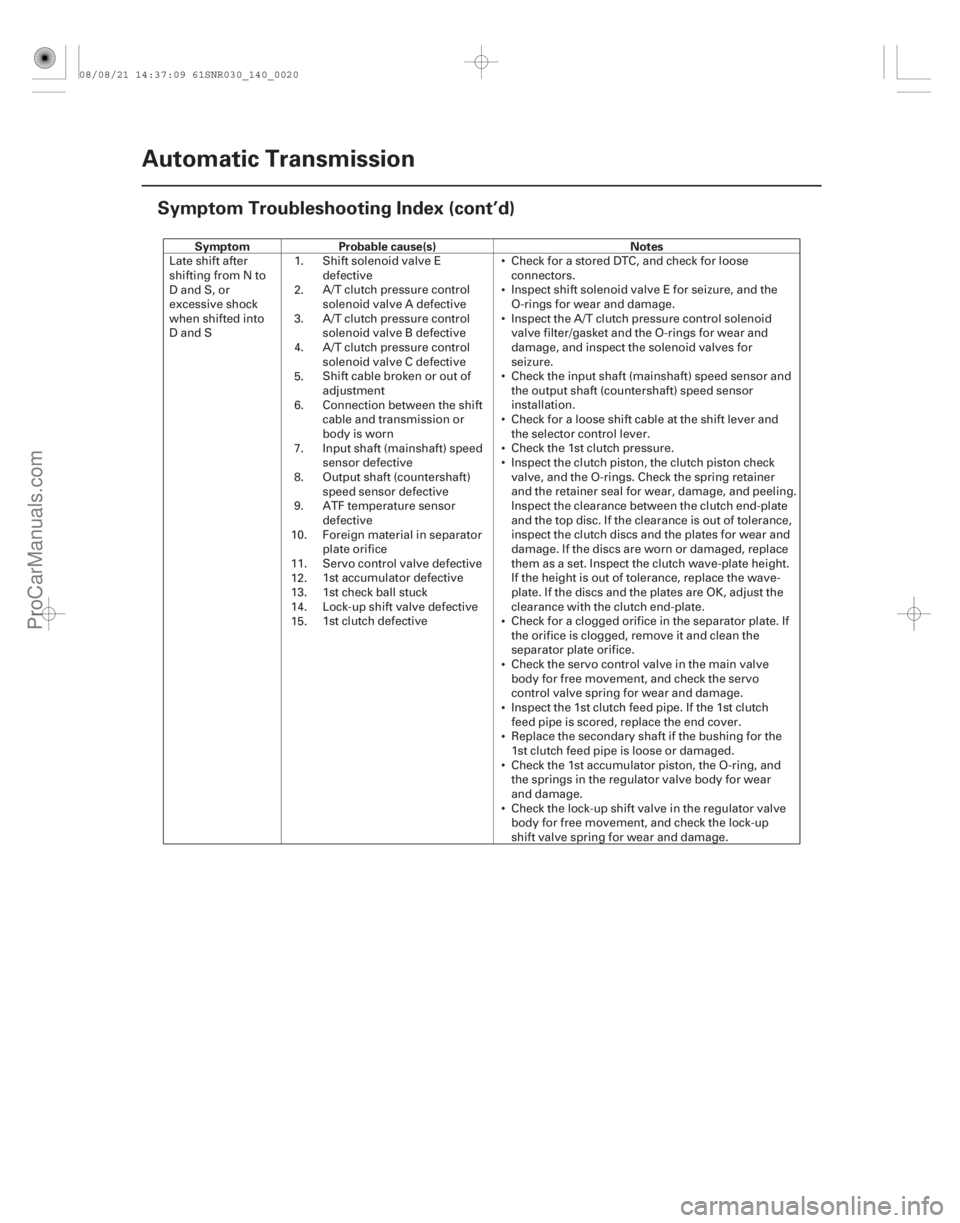
SymptomProbable cause(s) Notes
14-18Automatic Transmission
Symptom Troubleshooting Index (cont’d)
Late shift after
shifting from N to
D and S, or
excessive shock
when shifted into
DandS
1.
2.
3.
4.
5.
6.
7.
8.
9.
10.
11.
12.
13.
14.
15. Shift solenoid valve E
defective
A/T clutch pressure control
solenoid valve A defective
A/T clutch pressure control
solenoid valve B defective
A/T clutch pressure control
solenoid valve C defective
Shift cable broken or out of
adjustment
Connection between the shift
cable and transmission or
body is worn
Input shaft (mainshaft) speed
sensor defective
Output shaft (countershaft)
speed sensor defective
ATF temperature sensor
defective
Foreign material in separator
plate orifice
Servo control valve defective
1st accumulator defective
1st check ball stuck
Lock-up shift valve defective
1st clutch defective Check for a stored DTC, and check for loose
connectors.
Inspect shift solenoid valve E for seizure, and the
O-rings for wear and damage.
Inspect the A/T clutch pressure control solenoid
valve filter/gasket and the O-rings for wear and
damage, and inspect the solenoid valves for
seizure.
Check the input shaft (mainshaft) speed sensor and
the output shaft (countershaft) speed sensor
installation.
Check for a loose shift cable at the shift lever and
the selector control lever.
Check the 1st clutch pressure.
Inspect the clutch piston, the clutch piston check
valve, and the O-rings. Check the spring retainer
and the retainer seal for wear, damage, and peeling.
Inspect the clearance between the clutch end-plate
and the top disc. If the clearance is out of tolerance,
inspect the clutch discs and the plates for wear and
damage. If the discs are worn or damaged, replace
them as a set. Inspect the clutch wave-plate height.
If the height is out of tolerance, replace the wave-
plate. If the discs and the plates are OK, adjust the
clearance with the clutch end-plate.
Check for a clogged orifice in the separator plate. If
the orifice is clogged, remove it and clean the
separator plate orifice.
Check the servo control valve in the main valve
body for free movement, and check the servo
control valve spring for wear and damage.
Inspect the 1st clutch feed pipe. If the 1st clutch
feed pipe is scored, replace the end cover.
Replace the secondary shaft if the bushing for the
1st clutch feed pipe is loose or damaged.
Check the 1st accumulator piston, the O-ring, and
the springs in the regulator valve body for wear
and damage.
Check the lock-up shift valve in the regulator valve
body for free movement, and check the lock-up
shift valve spring for wear and damage.
08/08/21 14:37:09 61SNR030_140_0020
ProCarManuals.com
DYNOMITE -2009-
Page 935 of 2893
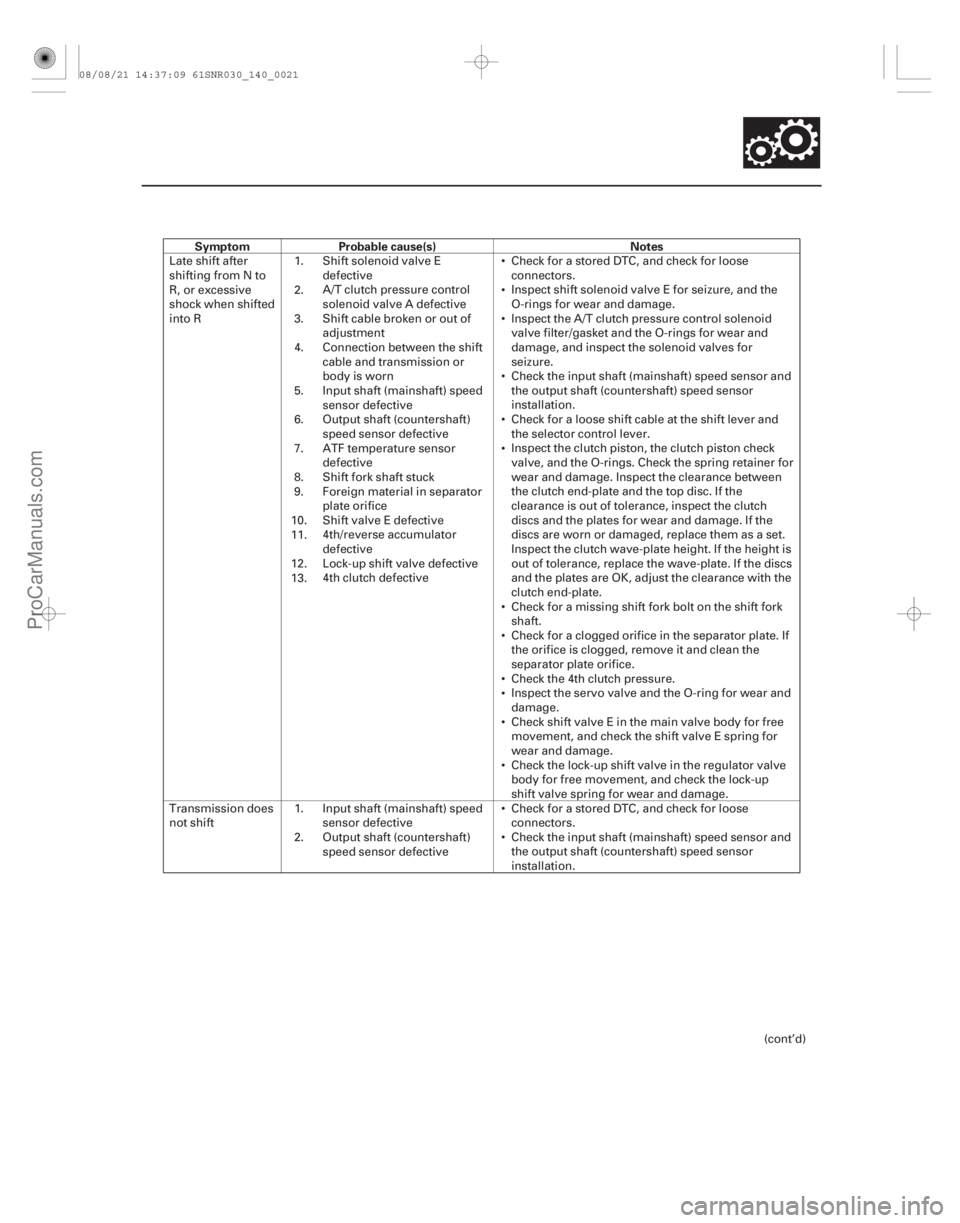
SymptomProbable cause(s) Notes
14-19
Late shift after
shifting from N to
R, or excessive
shock when shifted
into R
1.
2.
3.
4.
5.
6.
7.
8.
9.
10.
11.
12.
13. Shift solenoid valve E
defective
A/T clutch pressure control
solenoid valve A defective
Shift cable broken or out of
adjustment
Connection between the shift
cable and transmission or
body is worn
Input shaft (mainshaft) speed
sensor defective
Output shaft (countershaft)
speed sensor defective
ATF temperature sensor
defective
Shift fork shaft stuck
Foreign material in separator
plate orifice
Shift valve E defective
4th/reverse accumulator
defective
Lock-up shift valve defective
4th clutch defective Check for a stored DTC, and check for loose
connectors.
Inspect shift solenoid valve E for seizure, and the
O-rings for wear and damage.
Inspect the A/T clutch pressure control solenoid
valve filter/gasket and the O-rings for wear and
damage, and inspect the solenoid valves for
seizure.
Check the input shaft (mainshaft) speed sensor and
the output shaft (countershaft) speed sensor
installation.
Check for a loose shift cable at the shift lever and
the selector control lever.
Inspect the clutch piston, the clutch piston check
valve, and the O-rings. Check the spring retainer for
wear and damage. Inspect the clearance between
the clutch end-plate and the top disc. If the
clearance is out of tolerance, inspect the clutch
discs and the plates for wear and damage. If the
discs are worn or damaged, replace them as a set.
Inspect the clutch wave-plate height. If the height is
out of tolerance, replace the wave-plate. If the discs
and the plates are OK, adjust the clearance with the
clutch end-plate.
Check for a missing shift fork bolt on the shift fork
shaft.
Check for a clogged orifice in the separator plate. If
the orifice is clogged, remove it and clean the
separator plate orifice.
Check the 4th clutch pressure.
Inspect the servo valve and the O-ring for wear and
damage.
Check shift valve E in the main valve body for free
movement, and check the shift valve E spring for
wear and damage.
Check the lock-up shift valve in the regulator valve
body for free movement, and check the lock-up
shift valve spring for wear and damage.
Transmission does
not shift 1.
2.Input shaft (mainshaft) speed
sensor defective
Output shaft (countershaft)
speed sensor defective Check for a stored DTC, and check for loose
connectors.
Check the input shaft (mainshaft) speed sensor and
the output shaft (countershaft) speed sensor
installation.
(cont’d)
08/08/21 14:37:09 61SNR030_140_0021
ProCarManuals.com
DYNOMITE -2009-
Page 936 of 2893
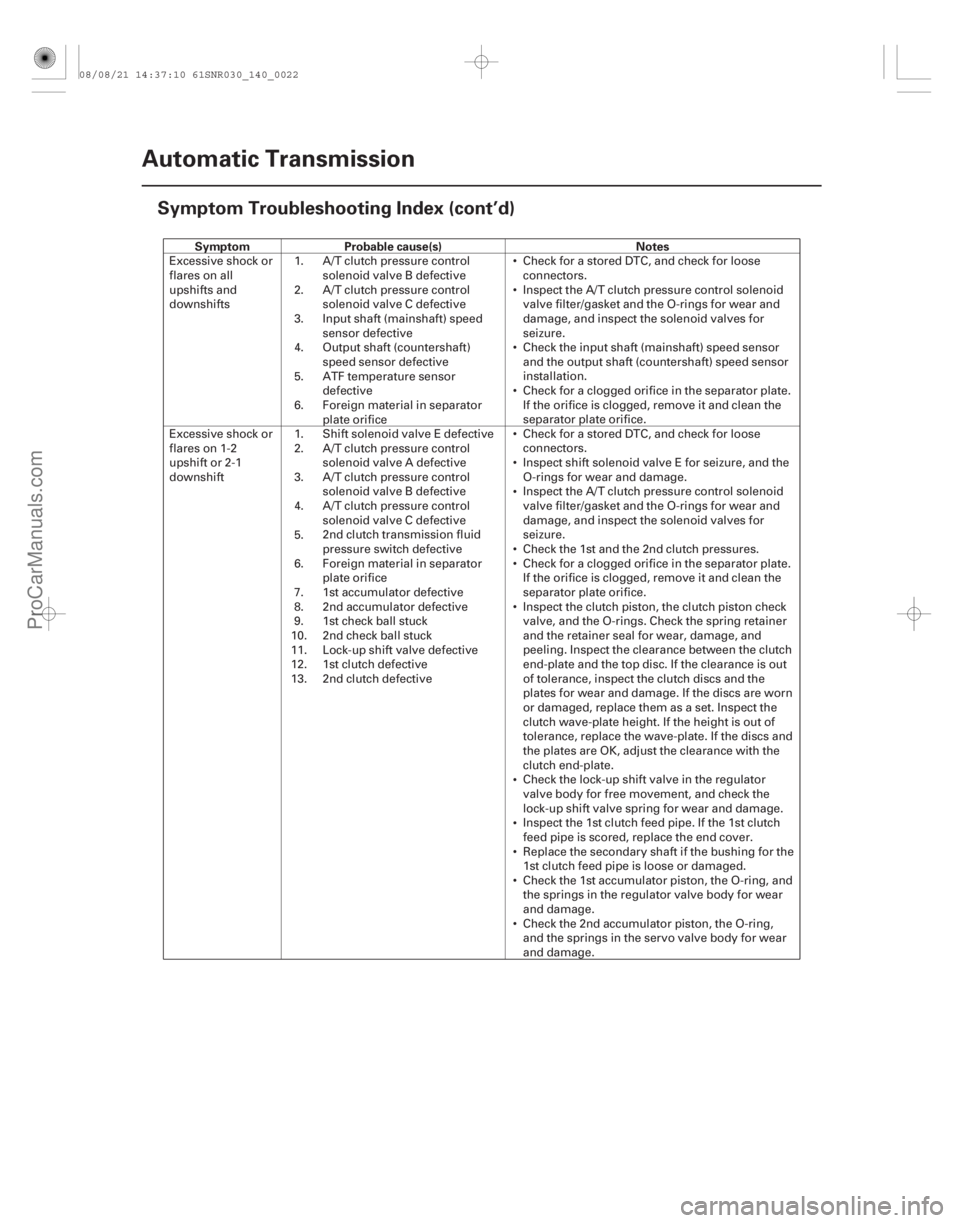
SymptomProbable cause(s) Notes
14-20Automatic Transmission
Symptom Troubleshooting Index (cont’d)
Excessive shock or
flares on all
upshifts and
downshifts
1.
2.
3.
4.
5.
6.A/T clutch pressure control
solenoid valve B defective
A/T clutch pressure control
solenoid valve C defective
Input shaft (mainshaft) speed
sensor defective
Output shaft (countershaft)
speed sensor defective
ATF temperature sensor
defective
Foreign material in separator
plate orifice Check for a stored DTC, and check for loose
connectors.
Inspect the A/T clutch pressure control solenoid
valve filter/gasket and the O-rings for wear and
damage, and inspect the solenoid valves for
seizure.
Check the input shaft (mainshaft) speed sensor
and the output shaft (countershaft) speed sensor
installation.
Check for a clogged orifice in the separator plate.
If the orifice is clogged, remove it and clean the
separator plate orifice.
Excessive shock or
flares on 1-2
upshift or 2-1
downshift 1.
2.
3.
4.
5.
6.
7.
8.
9.
10.
11.
12.
13. Shift solenoid valve E defective
A/T clutch pressure control
solenoid valve A defective
A/T clutch pressure control
solenoid valve B defective
A/T clutch pressure control
solenoid valve C defective
2nd clutch transmission fluid
pressure switch defective
Foreign material in separator
plate orifice
1st accumulator defective
2nd accumulator defective
1st check ball stuck
2nd check ball stuck
Lock-up shift valve defective
1st clutch defective
2nd clutch defective Check for a stored DTC, and check for loose
connectors.
Inspect shift solenoid valve E for seizure, and the
O-rings for wear and damage.
Inspect the A/T clutch pressure control solenoid
valve filter/gasket and the O-rings for wear and
damage, and inspect the solenoid valves for
seizure.
Check the 1st and the 2nd clutch pressures.
Check for a clogged orifice in the separator plate.
If the orifice is clogged, remove it and clean the
separator plate orifice.
Inspect the clutch piston, the clutch piston check
valve, and the O-rings. Check the spring retainer
and the retainer seal for wear, damage, and
peeling. Inspect the clearance between the clutch
end-plate and the top disc. If the clearance is out
of tolerance, inspect the clutch discs and the
plates for wear and damage. If the discs are worn
or damaged, replace them as a set. Inspect the
clutch wave-plate height. If the height is out of
tolerance, replace the wave-plate. If the discs and
the plates are OK, adjust the clearance with the
clutch end-plate.
Check the lock-up shift valve in the regulator
valve body for free movement, and check the
lock-up shift valve spring for wear and damage.
Inspect the 1st clutch feed pipe. If the 1st clutch
feed pipe is scored, replace the end cover.
Replace the secondary shaft if the bushing for the
1st clutch feed pipe is loose or damaged.
Check the 1st accumulator piston, the O-ring, and
the springs in the regulator valve body for wear
and damage.
Check the 2nd accumulator piston, the O-ring,
and the springs in the servo valve body for wear
and damage.
08/08/21 14:37:10 61SNR030_140_0022
ProCarManuals.com
DYNOMITE -2009-
Page 937 of 2893
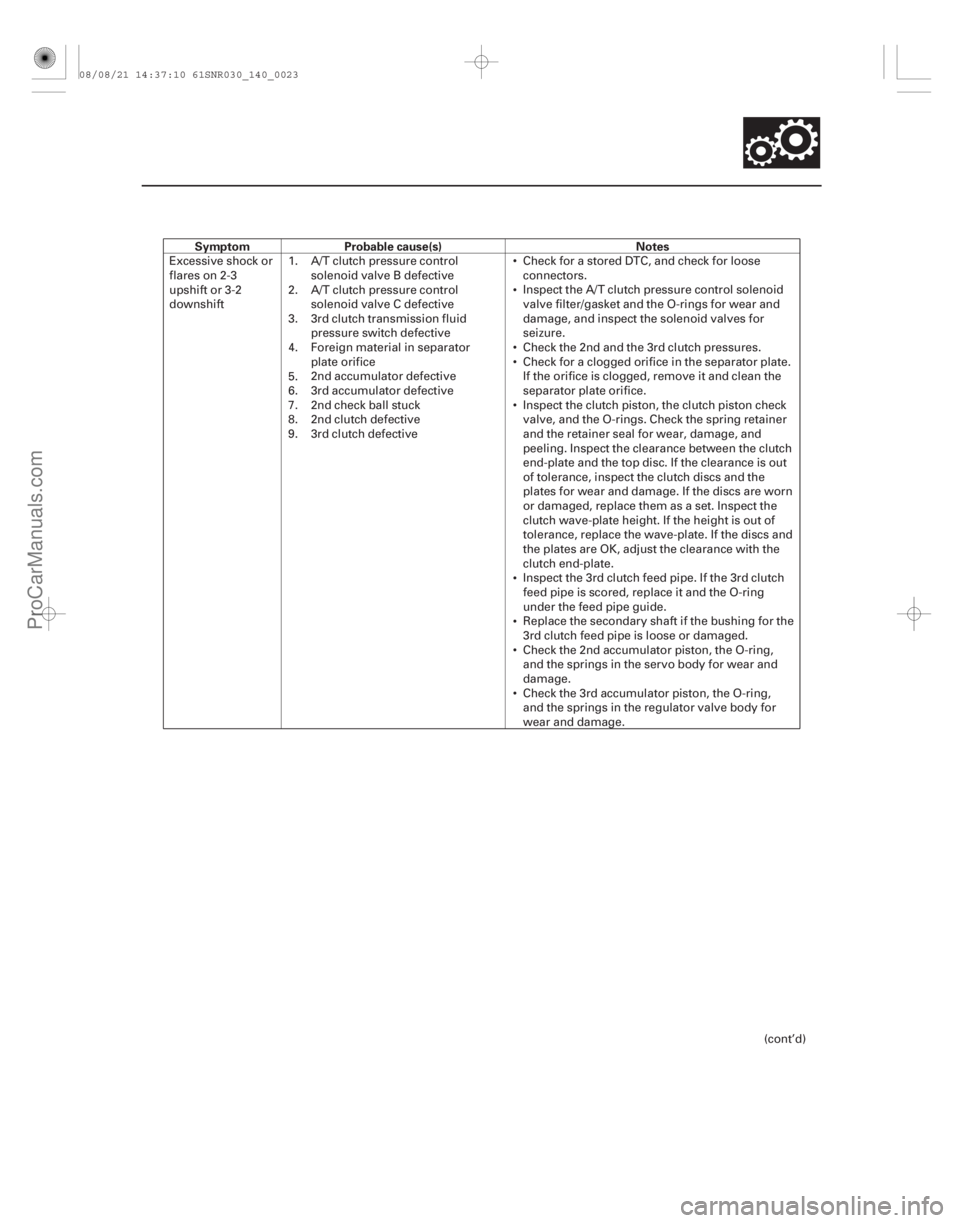
SymptomProbable cause(s) Notes
14-21
Excessive shock or
flares on 2-3
upshift or 3-2
downshift
1.
2.
3.
4.
5.
6.
7.
8.
9.A/T clutch pressure control
solenoid valve B defective
A/T clutch pressure control
solenoid valve C defective
3rd clutch transmission fluid
pressure switch defective
Foreign material in separator
plate orifice
2nd accumulator defective
3rd accumulator defective
2nd check ball stuck
2nd clutch defective
3rd clutch defective Check for a stored DTC, and check for loose
connectors.
Inspect the A/T clutch pressure control solenoid
valve filter/gasket and the O-rings for wear and
damage, and inspect the solenoid valves for
seizure.
Check the 2nd and the 3rd clutch pressures.
Check for a clogged orifice in the separator plate.
If the orifice is clogged, remove it and clean the
separator plate orifice.
Inspect the clutch piston, the clutch piston check
valve, and the O-rings. Check the spring retainer
and the retainer seal for wear, damage, and
peeling. Inspect the clearance between the clutch
end-plate and the top disc. If the clearance is out
of tolerance, inspect the clutch discs and the
plates for wear and damage. If the discs are worn
or damaged, replace them as a set. Inspect the
clutch wave-plate height. If the height is out of
tolerance, replace the wave-plate. If the discs and
the plates are OK, adjust the clearance with the
clutch end-plate.
Inspect the 3rd clutch feed pipe. If the 3rd clutch
feed pipe is scored, replace it and the O-ring
under the feed pipe guide.
Replace the secondary shaft if the bushing for the
3rd clutch feed pipe is loose or damaged.
Check the 2nd accumulator piston, the O-ring,
and the springs in the servo body for wear and
damage.
Check the 3rd accumulator piston, the O-ring,
and the springs in the regulator valve body for
wear and damage.
(cont’d)
08/08/21 14:37:10 61SNR030_140_0023
ProCarManuals.com
DYNOMITE -2009-
Page 938 of 2893
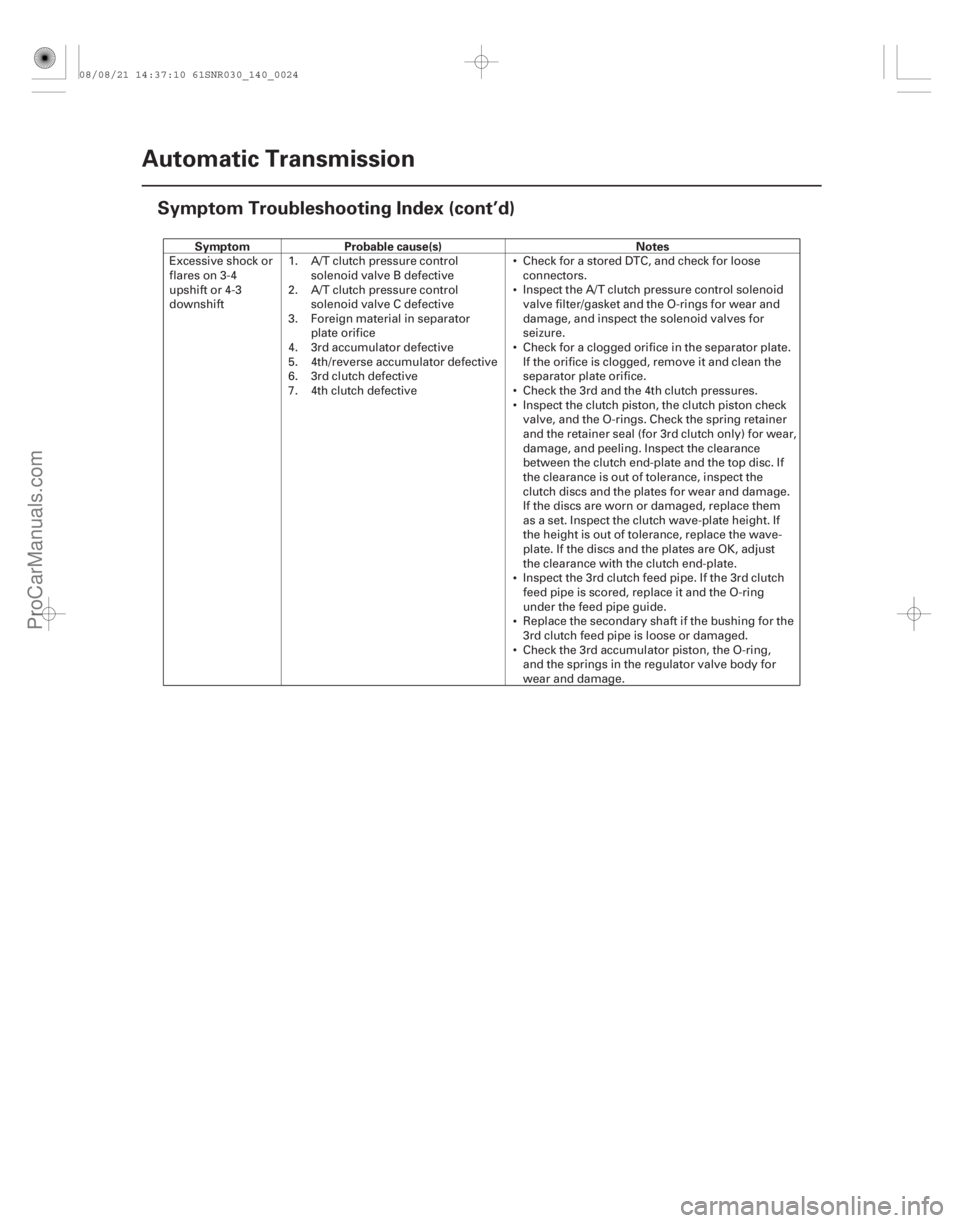
SymptomProbable cause(s) Notes
14-22Automatic Transmission
Symptom Troubleshooting Index (cont’d)
Excessive shock or
flares on 3-4
upshift or 4-3
downshift
1.
2.
3.
4.
5.
6.
7.A/T clutch pressure control
solenoid valve B defective
A/T clutch pressure control
solenoid valve C defective
Foreign material in separator
plate orifice
3rd accumulator defective
4th/reverse accumulator defective
3rd clutch defective
4th clutch defective Check for a stored DTC, and check for loose
connectors.
Inspect the A/T clutch pressure control solenoid
valve filter/gasket and the O-rings for wear and
damage, and inspect the solenoid valves for
seizure.
Check for a clogged orifice in the separator plate.
If the orifice is clogged, remove it and clean the
separator plate orifice.
Check the 3rd and the 4th clutch pressures.
Inspect the clutch piston, the clutch piston check
valve, and the O-rings. Check the spring retainer
and the retainer seal (for 3rd clutch only) for wear,
damage, and peeling. Inspect the clearance
between the clutch end-plate and the top disc. If
the clearance is out of tolerance, inspect the
clutch discs and the plates for wear and damage.
If the discs are worn or damaged, replace them
as a set. Inspect the clutch wave-plate height. If
the height is out of tolerance, replace the wave-
plate. If the discs and the plates are OK, adjust
the clearance with the clutch end-plate.
Inspect the 3rd clutch feed pipe. If the 3rd clutch
feed pipe is scored, replace it and the O-ring
under the feed pipe guide.
Replace the secondary shaft if the bushing for the
3rd clutch feed pipe is loose or damaged.
Check the 3rd accumulator piston, the O-ring,
and the springs in the regulator valve body for
wear and damage.
08/08/21 14:37:10 61SNR030_140_0024
ProCarManuals.com
DYNOMITE -2009-
Page 939 of 2893
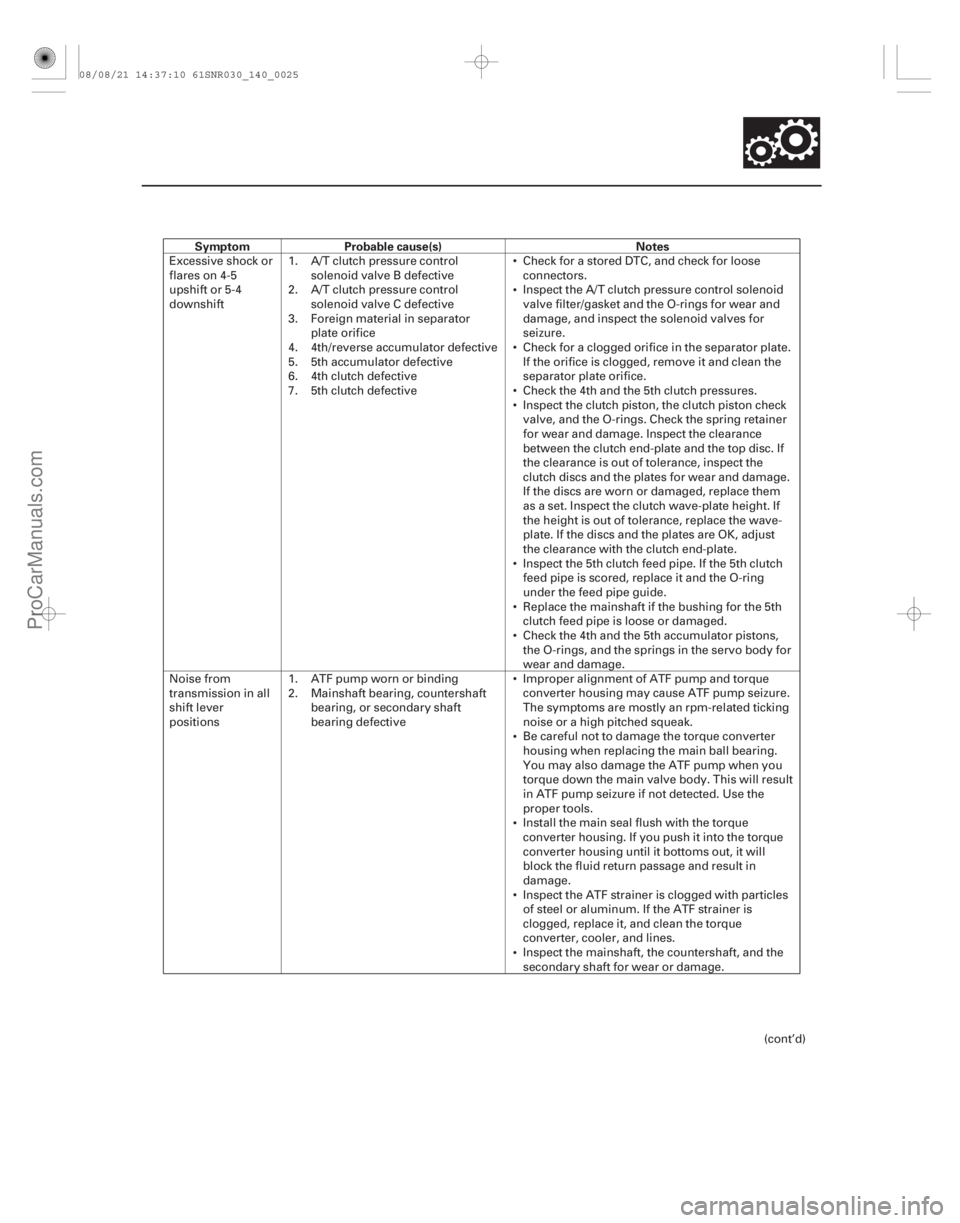
SymptomProbable cause(s) Notes
14-23
Excessive shock or
flares on 4-5
upshift or 5-4
downshift
1.
2.
3.
4.
5.
6.
7.A/T clutch pressure control
solenoid valve B defective
A/T clutch pressure control
solenoid valve C defective
Foreign material in separator
plate orifice
4th/reverse accumulator defective
5th accumulator defective
4th clutch defective
5th clutch defective Check for a stored DTC, and check for loose
connectors.
Inspect the A/T clutch pressure control solenoid
valve filter/gasket and the O-rings for wear and
damage, and inspect the solenoid valves for
seizure.
Check for a clogged orifice in the separator plate.
If the orifice is clogged, remove it and clean the
separator plate orifice.
Check the 4th and the 5th clutch pressures.
Inspect the clutch piston, the clutch piston check
valve, and the O-rings. Check the spring retainer
for wear and damage. Inspect the clearance
between the clutch end-plate and the top disc. If
the clearance is out of tolerance, inspect the
clutch discs and the plates for wear and damage.
If the discs are worn or damaged, replace them
as a set. Inspect the clutch wave-plate height. If
the height is out of tolerance, replace the wave-
plate. If the discs and the plates are OK, adjust
the clearance with the clutch end-plate.
Inspect the 5th clutch feed pipe. If the 5th clutch
feed pipe is scored, replace it and the O-ring
under the feed pipe guide.
Replace the mainshaft if the bushing for the 5th
clutch feed pipe is loose or damaged.
Check the 4th and the 5th accumulator pistons,
the O-rings, and the springs in the servo body for
wear and damage.
Noise from
transmission in all
shift lever
positions 1.
2.
ATF pump worn or binding
Mainshaft bearing, countershaft
bearing, or secondary shaft
bearing defective Improper alignment of ATF pump and torque
converter housing may cause ATF pump seizure.
The symptoms are mostly an rpm-related ticking
noise or a high pitched squeak.
Be careful not to damage the torque converter
housing when replacing the main ball bearing.
You may also damage the ATF pump when you
torque down the main valve body. This will result
in ATF pump seizure if not detected. Use the
proper tools.
Install the main seal flush with the torque
converter housing. If you push it into the torque
converter housing until it bottoms out, it will
block the fluid return passage and result in
damage.
Inspect the ATF strainer is clogged with particles
of steel or aluminum. If the ATF strainer is
clogged, replace it, and clean the torque
converter, cooler, and lines.
Inspect the mainshaft, the countershaft, and the
secondary shaft for wear or damage.
(cont’d)
08/08/21 14:37:10 61SNR030_140_0025
ProCarManuals.com
DYNOMITE -2009-
Page 940 of 2893
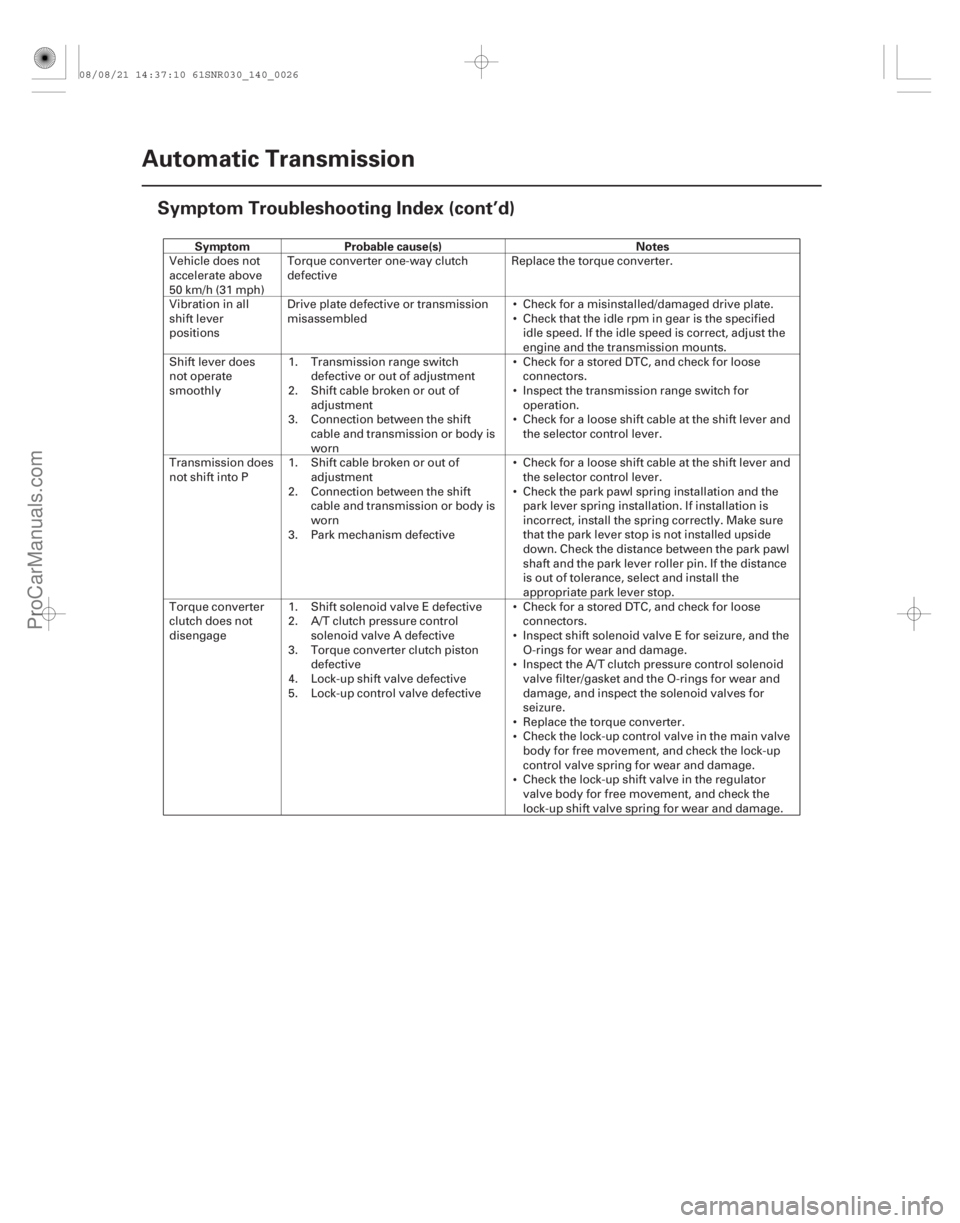
SymptomProbable cause(s) Notes
14-24Automatic Transmission
Symptom Troubleshooting Index (cont’d)
Vehicle does not
accelerate above
50 km/h (31 mph)
Torque converter one-way clutch
defective
Replace the torque converter.
Vibrationinall
shift lever
positions Drive plate defective or transmission
misassembled
Check for a misinstalled/damaged drive plate.
Check that the idle rpm in gear is the specified
idle speed. If the idle speed is correct, adjust the
engine and the transmission mounts.
Shift lever does
not operate
smoothly 1.
2.
3.Transmission range switch
defective or out of adjustment
Shift cable broken or out of
adjustment
Connection between the shift
cable and transmission or body is
worn Check for a stored DTC, and check for loose
connectors.
Inspect the transmission range switch for
operation.
Check for a loose shift cable at the shift lever and
the selector control lever.
Transmission does
not shift into P 1.
2.
3.Shift cable broken or out of
adjustment
Connection between the shift
cable and transmission or body is
worn
Park mechanism defective Check for a loose shift cable at the shift lever and
the selector control lever.
Check the park pawl spring installation and the
park lever spring installation. If installation is
incorrect, install the spring correctly. Make sure
that the park lever stop is not installed upside
down. Check the distance between the park pawl
shaft and the park lever roller pin. If the distance
is out of tolerance, select and install the
appropriate park lever stop.
Torque converter
clutch does not
disengage 1.
2.
3.
4.
5.Shift solenoid valve E defective
A/T clutch pressure control
solenoid valve A defective
Torque converter clutch piston
defective
Lock-up shift valve defective
Lock-up control valve defective Check for a stored DTC, and check for loose
connectors.
Inspect shift solenoid valve E for seizure, and the
O-rings for wear and damage.
Inspect the A/T clutch pressure control solenoid
valve filter/gasket and the O-rings for wear and
damage, and inspect the solenoid valves for
seizure.
Replace the torque converter.
Check the lock-up control valve in the main valve
body for free movement, and check the lock-up
control valve spring for wear and damage.
Check the lock-up shift valve in the regulator
valve body for free movement, and check the
lock-up shift valve spring for wear and damage.
08/08/21 14:37:10 61SNR030_140_0026
ProCarManuals.com
DYNOMITE -2009-